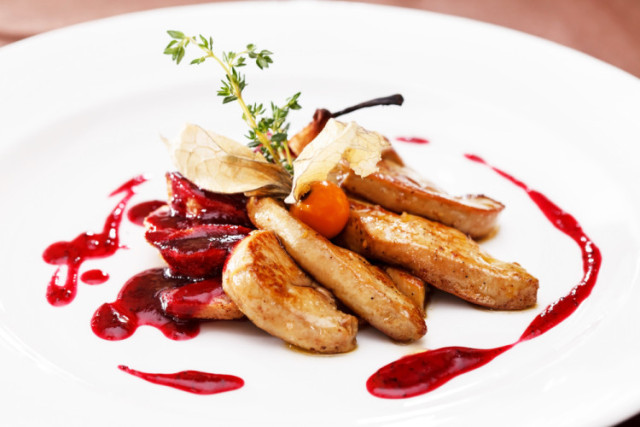
By Marina Starkey
According to Gawker it absolutely is, and they were even meaner about it. But if we at The Culture-ist are trying to be unbiased, objective, and maintain some semblance of proper journalistic practice, we believe there is more to the story than a few brash words.
For those who are unfamiliar with it, foie gras is a French delicacy made from duck or goose liver that has been specially fattened to achieve a rich and delicate texture. It can be turned into a pâté, a mousse, or eaten as is with the accompaniment of another food. I had the opportunity to try foie gras for the first time at a Boston restaurant called Clio as part of their nine course tasting menu. It was paired with molasses candy, hibiscus, bee pollen, and cherry blossom. The sweetness provided the perfect complement to the savory and buttery foie gras, creating a perfectly balanced dish. Suffice to say, it was delicious and unlike anything I’ve ever eaten. I was intrigued by the world I was just opened up to and dying to experiment with all the flavor profiles possible with this mysterious duck liver.
That world of possibility soon closed its doors in my face.
About a week after my foie gras cherry popped, the California foie gras ban was lifted. This caused me to do some more research as to why an entire state would ban a food to begin with. Subsequently, the true nature of foie gras and how it’s made ceased to be a mystery.
Let me give you some cold, cold facts. Foie gras is made by force-feeding ducks and geese with a process called gavage. Gavage is shoving a plastic tube down the throats of these birds and feeding them more than they would ever eat, naturally or domestically. The feed deposits large amounts of fat into their livers, causing them to swell, which also causes the buttery consistency that is so essential to delicious foie gras.
Because of the controversial nature of these practices, the people of California voted to ban foie gras from being served across the state in 2004. The law prohibits the force-feeding of birds for the purpose of enlarging its liver beyond normal size, thus turning the traditional method of producing foie gras into a distant memory. This, however, turned out to have little effect on out-of-state retailers of the delicacy. As of January 2015, a court ruling stated that restaurants can’t be barred from serving imported foie gras. Foodies and chefs across the state rejoiced. Don’t you love loopholes?
This didn’t stop animal rights activists everywhere from getting really angry at chefs who announced they would start serving the controversial dish in their restaurants. Protestors, threats of torture and death persisted, and are still happening until an appeal goes through.
I don’t think the story ends here, however. Yes, the methods of force-feeding ducks and geese seems a bit medieval. It’s hard to believe we haven’t come up with other means of production. But we can’t be exclusive. Not all foie farms conjure up this image of animal torture.
Hudson Valley Foie Gras looks like a farm so pleasant I could almost live there. It’s situated on 200 acres in Ferndale, New York and is run by Izzy Yanay and Michael Ginor. Their website discusses their procedure for feeding, and it sounds significantly less horrifying.
According to them, the throat of a water fowl is lined with a tissue that allows it to accept harsher foods, including a feeding tube. They do not have a protective gag reflex and can breathe normally during feeding. Also, storing excessive fat in their livers is apparently very common, as they often overeat in nature to take advantage of finding an abundance of food. They say the animals never suffer and have the ability to run free if they feel themselves in danger (Hudson Valley Fois Gras).
But to PETA, things look slightly different. To use their own words, “…workers ram pipes down male ducks’ or geese’s throats two or three times daily and pump as much as four pounds of grain and fat into the animals’ stomachs, causing their livers to swell to up to 10 times their normal size. Many birds have difficulty standing because of their engorged livers, and they may tear out their own feathers and cannibalize each other out of stress.” (PETA)
PETA also conducted an investigation of Hudson Valley and discovered just how many ducks died when their organs ruptured. Allegedly, workers were awarded a pay bonus if they killed fewer than fifty birds a month. They go on to list all the numerous ways the birds are mistreated on this farm. At this rate, until we visit Hudson Valley ourselves, the jury will be out.
So does eating foie gras really make us jerks? For all the vegetarians and vegans out there, it might. Personally I believe that whatever animal I’m eating really shouldn’t be tortured for my fleeting enjoyment. But if you fiend for that buttery, indulgent bite of foie gras every now and then, maybe you should just say a little prayer for the duck that allowed this happiness before you dig in. To each his own foie.
ABOUT THE WRITER
 Marina is a student who finds most of her comfort in food and in cooking. She runs her own adventurous food blog, fondly called “Marinated” which you can explore at www.marinatedblog.com. While studying abroad in London, she realized that all she wants from life is to eat through all of the cities in the world and write about it. In between meals, Marina enjoys reading and writing poetry, playing her ukulele, and dreaming up the places she wants to travel to next. She’s currently finishing her degree in Writing, Literature, & Publishing at Emerson College and is pretending the future isn’t happening yet.
Marina is a student who finds most of her comfort in food and in cooking. She runs her own adventurous food blog, fondly called “Marinated” which you can explore at www.marinatedblog.com. While studying abroad in London, she realized that all she wants from life is to eat through all of the cities in the world and write about it. In between meals, Marina enjoys reading and writing poetry, playing her ukulele, and dreaming up the places she wants to travel to next. She’s currently finishing her degree in Writing, Literature, & Publishing at Emerson College and is pretending the future isn’t happening yet.


